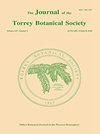Experimental Test of the Role of Mammalian Herbivores on Old Field Succession: Community Structure and Seedling Survival
IF 0.8
4区 生物学
Q4 PLANT SCIENCES
引用次数: 49
Abstract
CADENASSO, M.L., S.TA. PIcKETr (Institute of Ecosystem Studies, Box AB, Millbrook, NY 12545) AND PJ. MoRiN (Department of Ecology, Evolution, and Natural Resources, 14 College Farm Road, Cook College, Rutgers University, New Brunswick, NJ 08901). Experimental test of the role of mammalian herbivores on old field succession: community structure and seedling survival. J. Torrey Bot. Soc. 129:228-237. 2002.-When elucidating plant community dynamics, investigators have focused on plant-plant and plant-environment interactions and on the characteristics of individual plants. The role of animals has been relatively neglected. Herbivory may affect vegetation dynamics by altering community composition and structure and by influencing the performance of species. Therefore, herbivory can be an important factor in succession. We experimentally tested the role of mammalian herbivores in two fields at the Hutcheson Memorial Forest Center in central New Jersey. Both fields were released from active cultivation, one at the beginning of the experiment and the other 17 years earlier. Large exclosures (5 X 5 m) were used to exclude mammalian herbivores, and open units of the same size were used as controls. The effect of herbivore exclusion on the structure and composition of the plant community was analyzed. In addition, tree seedlings of three species-Acer rubrum, Cornus florida, and Juniperus virginiana-were planted in the experimental units in both fields. These species typically invade earlyto mid-successional old fields. The survival of these individuals was calculated and, using height as an indicator, their performance assessed. Herbivore exclusion primarily influenced the structure of the plant community rather than its composition. Percent cover of species and species richness of all plants were not affected by herbivory, but in one field the relative cover of exotics was greater in the exclosures. The height profile of the plant community in the exclosures was significantly taller than the community in the open plots. The survival and growth of planted A. rubrum and C. florida seedlings was significantly greater when protected from herbivores. In contrast, the survival and growth of J. virginiana seedlings was not affected by herbivores. Growth and survival of J. virginiana did differ by the field they were planted in, suggesting that physiological constraints may be more important than herbivory for this species. These results reenforce that herbivorous mammals play a key role in old field succession, particularly in the pivotal shift of dominance from herbaceous to woody cover.哺乳草食动物对老田演替作用的实验检验:群落结构和幼苗存活
卡德纳索,m.l.s.ta。(生态系统研究所,Box AB, milbrook, NY 12545);Rutgers University Cook College Farm Road 14, New Brunswick, NJ 08901,生态,进化和自然资源系。哺乳草食动物对老田演替作用的实验检验:群落结构和幼苗存活。托里·博特。Soc。129:228 - 237。2002.在阐明植物群落动态时,研究人员主要关注植物与植物、植物与环境的相互作用以及单个植物的特征。动物的作用相对被忽视了。草食可以通过改变群落组成和结构以及影响物种的表现来影响植被动态。因此,食草性可能是演替的一个重要因素。我们在新泽西州中部的哈奇森纪念森林中心的两个领域实验测试了哺乳动物食草动物的作用。这两块地都停止了积极耕种,一块是在试验开始时,另一块是在17年前。采用大型封闭空间(5 X 5 m)排除哺乳动物和草食动物,并采用相同大小的开放式单元作为对照。分析了排除草食动物对植物群落结构和组成的影响。此外,在两个试验田的试验单元中种植了三种树种——红槭、佛罗里达山茱萸和弗吉尼亚杜松的幼苗。这些物种通常入侵早至中期演替的旧田。计算这些个体的存活率,并以身高为指标,评估它们的表现。草食动物排斥主要影响植物群落的结构,而不是其组成。所有植物的物种盖度百分比和物种丰富度均不受草食的影响,但在同一块地的封地中,外来植物的相对盖度较大。封育区植物群落高度分布显著高于开放区。在不受草食动物侵害的情况下,人工种植的红桫椤和佛罗里达桫椤幼苗的成活率和生长率显著提高。相比之下,植食动物对维吉尼亚幼苗的存活和生长没有影响。弗吉尼亚菊的生长和存活确实因其种植的田地而异,这表明生理限制可能比食草性对该物种更重要。这些结果表明,草食性哺乳动物在原野演替中起着关键作用,特别是在优势从草本植被向木质植被的关键转变中。
本文章由计算机程序翻译,如有差异,请以英文原文为准。
求助全文
约1分钟内获得全文
求助全文
来源期刊
CiteScore
0.70
自引率
0.00%
发文量
16
审稿时长
>12 weeks
期刊介绍:
The Journal of the Torrey Botanical Society (until 1997 the Bulletin of the Torrey Botanical Club), the oldest botanical journal in the Americas, has as its primary goal the dissemination of scientific knowledge about plants (including thallopyhtes and fungi). It publishes basic research in all areas of plant biology, except horticulture, with an emphasis on research done in, and about plants of, the Western Hemisphere.

 求助内容:
求助内容: 应助结果提醒方式:
应助结果提醒方式:


